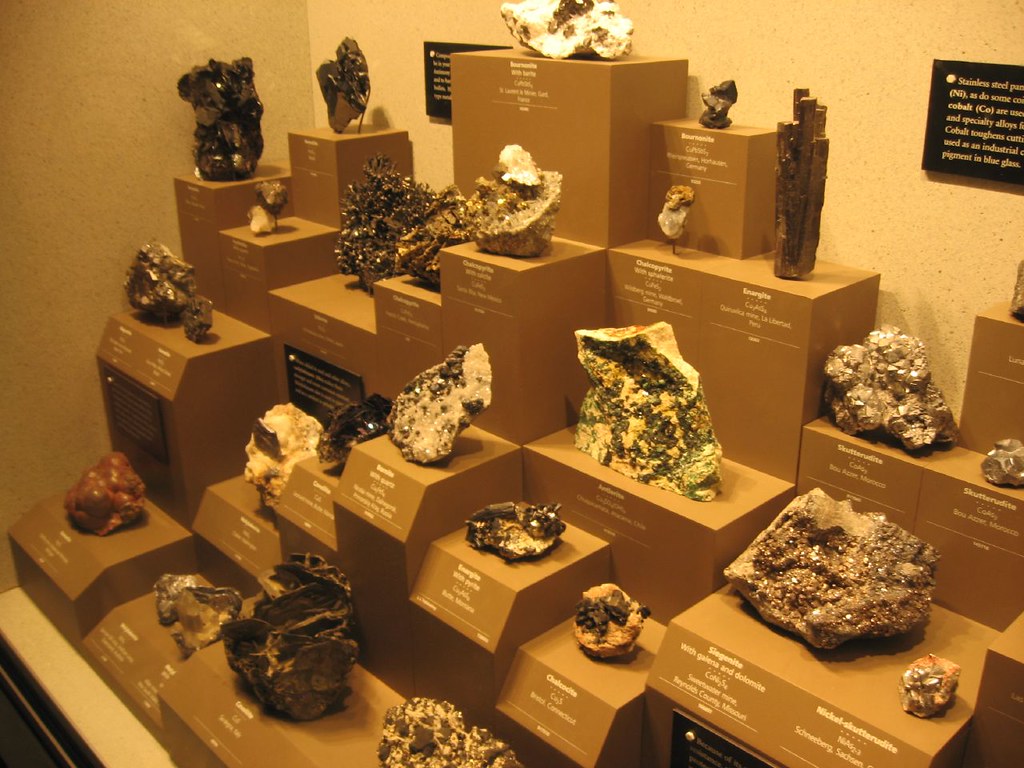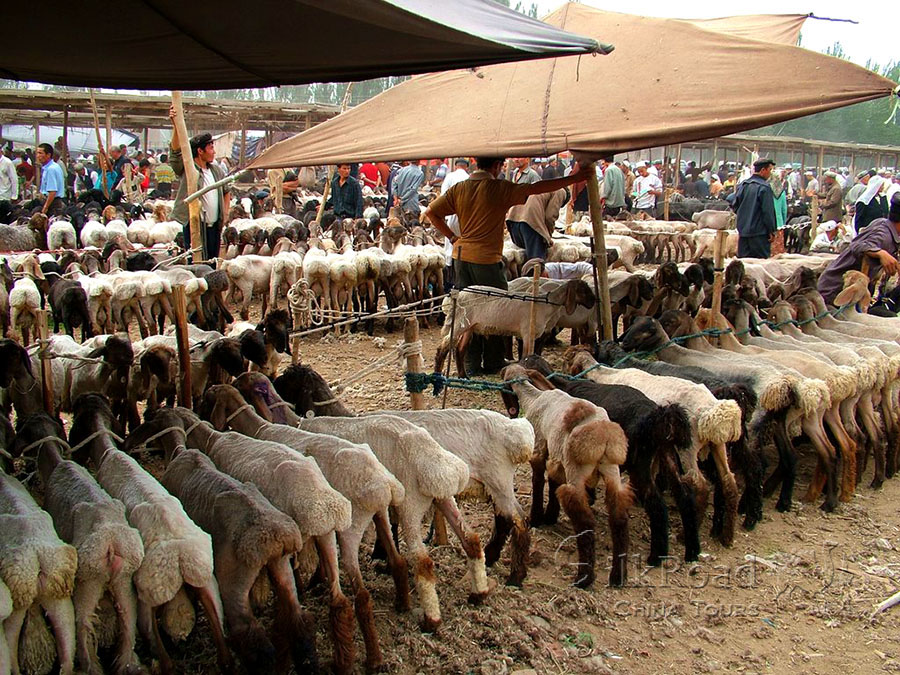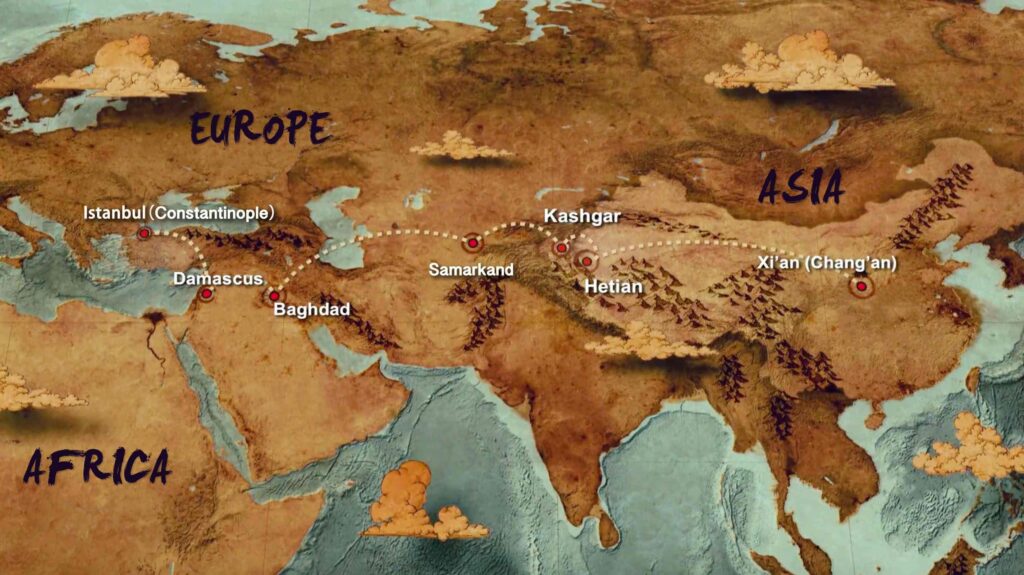Introduction
The Silk Road stands as one of the most profound and transformative trade networks in history, shaping not just the economies of the civilizations it connected but also their cultures, religions, and technological advancements. It spanned thousands of miles, linking East Asia, the Indian subcontinent, Central Asia, the Middle East, and parts of Europe and Africa. For over a millennium, the Silk Road facilitated the exchange of commodities, ideas, technologies, and cultural practices, making it an essential driver of global connectivity and shaping the development of societies from ancient China to the Roman Empire. Beyond its role as a commercial artery, the Silk Road played a critical role in fostering diplomacy, intellectual exchange, and the diffusion of religions, technologies, and artistic traditions.
Early Foundations and Geographic Scope

Origins and Development
The roots of the Silk Road can be traced to the Han Dynasty in China (206 BCE–220 CE), under the reign of Emperor Wu. Military expeditions to Central Asia led to the establishment of the first significant overland trade routes linking China to the West. This set in motion the flow of goods and cultural exchanges that would last for centuries. However, the Silk Road truly came into prominence during the Roman Empire and the subsequent expansion of the Parthian Empire in Persia.
The routes stretched from Chang’an (modern-day Xi’an) in China to the Mediterranean, and other important branches connected the Indian subcontinent, the Arabian Peninsula, and parts of Africa. It was not a single continuous road but rather a web of overland and maritime routes, including the Northern Route, which traversed the steppes of Central Asia, and the Southern Route, which passed through India, the Middle East, and in to Europe.
The Role of the Silk Road in Cultural Exchange

Spread of Religions
The Silk Road was instrumental in the transmission of major world religions. Buddhism, originating in India, spread through Central Asia to China and beyond, with monks and missionaries carrying scriptures and teachings. The region of Khotan in modern-day Xinjiang became a key center for the propagation of Buddhist teachings. Similarly, Islam spread along these routes during the early centuries of the Islamic Caliphates, reaching Central Asia, India, and China. The spread of Christianity also found its way along these routes, particularly through missionary work and trade between the Roman Empire and the Sassanian Empire.
The Manichaean and Nestorian Christianity traditions, which thrived in Central Asia, are prime examples of religious ideologies that spread due to the activities along the Silk Road. The exchange of religious iconography, sacred texts, and practices helped enrich the spiritual landscape of Central Asia and the broader Eurasian continent.
Cultural Interactions and the Exchange of Art

The art and material culture along the Silk Road were not confined to one civilization but emerged as a melting pot of different influences. Central Asian cities like Samarkand, Bukhara, and Merv were hubs where artistic styles from China, Persia, India, and Greece merged. Buddhist art, which had its roots in Indian iconography, blended with Greek and Persian elements, giving rise to unique styles like Gandharan art that influenced the development of Buddhist sculpture in China and other East Asian regions.
The import of Persian carpets, silk textiles, and Chinese porcelain into Europe became highly prized luxury items, while Persian miniature paintings and ceramic arts inspired the artistic traditions of regions far beyond Persia. Chinese innovations in bronze casting and lacquerware spread westward, influencing various empires, including the Byzantine.
Culinary Influence
As goods like spices, tea, and fruits traveled westward, they profoundly impacted diets and culinary traditions. The spread of spices such as cinnamon, cloves, and nutmeg from the East to the West is an example of how the exchange of goods also facilitated cultural and culinary transformations. The consumption of tea, which originated in China, eventually reached Europe and the Middle East. The influence of rice and noodles spread across Asia and into the Middle East, further enhancing cross-cultural exchange.
Trade and Economic Impact

Commodities Traded
While silk remains the most iconic product traded along the Silk Road, it was far from the only valuable commodity exchanged. Over time, the network facilitated the transfer of:
Spices:

Pepper, cinnamon, and cloves were among the most prized commodities from Southeast Asia and India, reaching Europe and the Middle East.
Tea:

The Chinese export of tea became a significant item in global trade, particularly influencing Chinese trade relationships with Japan, Russia, and the West.
Glassware and Pottery:

Islamic glass-making techniques, as well as Chinese porcelain, found their way to both the West and the East.
Precious Metals and Gems:

Gold, silver, and precious stones like lapis lazuli, sourced from Afghanistan and Central Asia, were among the luxury goods traded.
Animals and Livestock:

Horses, camels, and other livestock were exchanged between the East and West, crucial for travel and military campaigns.
Intermediary Role of Central Asian Merchants
Central Asia became the melting pot of trade, where merchants from the Sogdian culture, Persians, Arabs, Turks, and Indians played a central role in facilitating commerce. Sogdian merchants are particularly famous for their role in establishing trade routes across the Silk Road, linking the Chinese, Persian, and Roman worlds. These traders acted not only as business intermediaries but also as cultural conduits, bringing diverse languages, customs, and technological innovations together.
Economic Growth and Urbanization
The Silk Road spurred the development of trade centers and caravansary-in for merchants and their caravans, providing critical infrastructure along the route. Cities like Bukhara, Samarkand, Kashgar, and Chang’an grew as thriving commercial hubs, encouraging the development of markets, banking systems, and urban cultures.
Trade along the Silk Road played a significant role in fostering the rise of powerful empires. The Tang Dynasty in China, the Byzantine Empire, and the Persian Sassanid Empire all prospered from their strategic position along these routes. As cities grew, they became centers for artistic, scientific, and intellectual exchange.
Technology and Scientific Advancements

Paper and Printing
One of the most important technological contributions of the Silk Road was the spread of paper-making technology from China. This innovation spread westward, eventually reaching the Islamic world and Europe, leading to the development of printing presses in the 15th century.
Gunpowder and the Compass
Two other Chinese inventions, gunpowder and the magnetic compass, were introduced to the Middle East and Europe via the Silk Road, revolutionizing both warfare and navigation. Gunpowder, originally used for fireworks and signaling, later became a critical component in the development of firearms and cannons. The magnetic compass enabled European sailors to navigate across oceans, facilitating the age of exploration.
Medical Knowledge and Astronomical Instruments
The Silk Road also facilitated the exchange of medical knowledge. Islamic scholars translated Greek medical texts, which were later passed on to European Renaissance scientists. Astronomical instruments and mathematical texts from the Middle East and India were incorporated into Chinese scientific knowledge, enriching both regions’ understandings of the cosmos.
Decline and End of the Silk Road

Mongol Invasions and the Black Death
The rise of the Mongol Empire in the 13th century provided a temporary revival for the Silk Road, with the Pax Mongolica ensuring safe passage for traders and diplomats across Asia. However, the spread of the Black Death in the 14th century devastated populations along the trade routes, severely disrupting commerce. The Mongol Empire’s fragmentation, combined with the rise of new maritime routes by the Ottomans and European powers, marked the gradual decline of the overland Silk Road.
The Rise of Maritime Trade
As the Ottoman Empire gained control of key land routes, European nations sought new routes to Asia by sea. The age of exploration, marked by voyages of Christopher Columbus and Vasco da Gama, diminished the importance of the overland routes in favor of sea-based trade routes.
Legacy of the Silk Road

The impact of the Silk Road on global history cannot be overstated. It facilitated the exchange of not only goods but also culture, science, religion, and ideas. The Silk Road laid the foundation for modern globalization by connecting disparate regions, fostering mutual exchange, and promoting cross-cultural understanding.
In the modern world, the idea of the Silk Road has come to symbolize the interconnections of human societies and the enduring power of trade and cultural exchange. The lessons of the Silk Road continue to resonate in today’s global economy, reminding us of the importance of building bridges between cultures and civilizations.
Conclusion
The Silk Road was more than just a commercial route; it was a dynamic and transformative network that reshaped the course of world history. By facilitating the exchange of goods, technologies, and ideas, it bridged the East and West in ways that continue to influence our world today. Its legacy is a reminder of the enduring power of human connection and the incredible potential of cross-cultural exchange. The Silk Road not only brought the world closer together but also laid the groundwork for the globalized societies we inhabit today.



2 thoughts on “THE SILK ROAD: BRIDGING CULTURES AND CIVILIZATIONS ACROSS CONTINENTS”